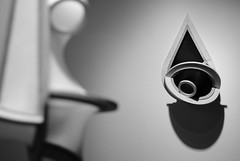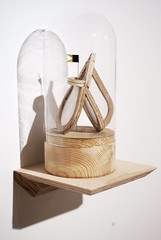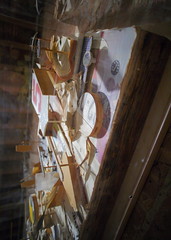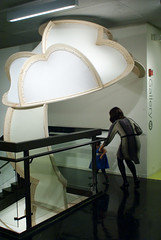Along with an understanding of solid wood's hygroscopic character and corresponding dimensional instability, the (traditional) woodworker's foremost concern--fiber orientation--has disappeared from the art offered by Chávez.
The pieces on display at Linda Warren Gallery are not born of any refined craft; they're as raw as they are fragile. And by virtue of the means and material of their fabrication they're almost wholly disconnected from the history of woodwork prior to WWII. Whether in the final analysis determined to be helpful or harmful to the artwork, such things ought to be considered as noteworthy in every preliminary estimation.

Plywood is an engineered material; it's designed to "overcome" the natural behavior of its chief component. Plywood consists of veneer (ply) stacked upon veneer; each layer's fibers are set perpendicular to the fibers of the layer immediately preceding; the whole affair is held together (laminated) with synthetic resin. Only recent developments in "glue" technology have made plywood an affordable, stable and popular choice across a broad spectrum of applications.
Looking closely, Chávez tends to produce wood-colored and wood-textured objects which are not made of "real" wood; rather, they are simulacra thereof. Chávez creates sometimes fanciful and sometimes ominous structures which are surreal and abstract. In many cases, without question, the incorporation of found objects predetermines the scale and proportion of the finished piece.

Chávez is a builder, not a carver. "Wood," i.e., lumber, is produced by cutting trees; it's formed through a subtractive process. "Plywood" is built from lumber; it's the end result of an additive process. Tree trunks are irregular, three-dimensional (roughly conical) shapes; plywood is uniform, and nearly two-dimensional. As a practical matter, the use of plywood and not wood might be thought to make the task of fabrication easier and faster for Chávez .
Essentially, in his most recognizable idiom, Chávez "draws" geometric and quasi-organic figures with the aid of "contour lines" cut from plywood. Fabric stretched across said plywood framing conveys a potential volume; the mechanical fasteners used therein hold not canvas or linen but rather (often) Lycra panels. Like plywood, Lycra is a relatively modern innovation--in this case an innovation producing cloth with a flexibility greater than natural fibers would otherwise impart.

Chávez isn't (manifestly) interested in Nature, or in natural limitations. Rather, his work--sculpture, collage, installation, whatever form it takes--tends to incorporate and resemble things made by the imagination of Man. In a formal sense, the strongest of the pieces (shown by Chávez over time in Chicago) draw near to Richard Deacon. Chávez is distinctive in his ability to work along a vertical axis. At his best, Chávez is playful and his artworks rise lightly: like a child's bubbling laughter.
Whether the recreation of American urban decay, a tendency also found across the body of work attributable to Chávez, should in time prove more prescient is unpleasant to consider.

Above: Juan Angel Chávez @ Linda Warren, December 11, 2009 - January 16, 2010

Above: Juan Angel Chávez @ Hyde Park Art Center, November 8, 2009 - January 24, 2010
Juan Angel Chávez
April 15 – May 14, 2011
Linda Warren Gallery: Project Space
1052 W Fulton Market
Chicago, IL 60607
http://www.lindawarrengallery.com
- Paul Germanos
No comments:
Post a Comment